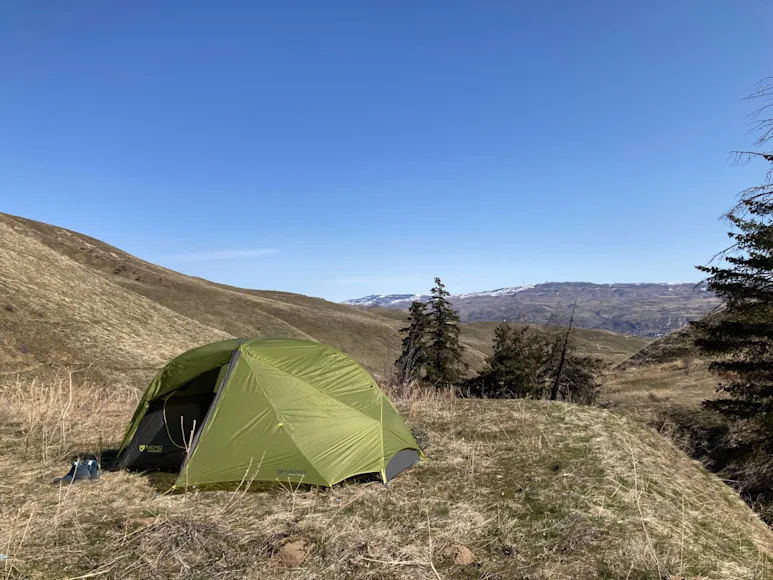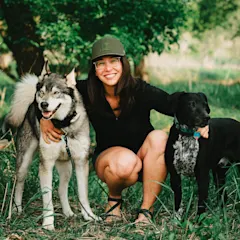_We may earn revenue from the products available on this page and participate in affiliate programs. Learn more ›
_
Best Overall
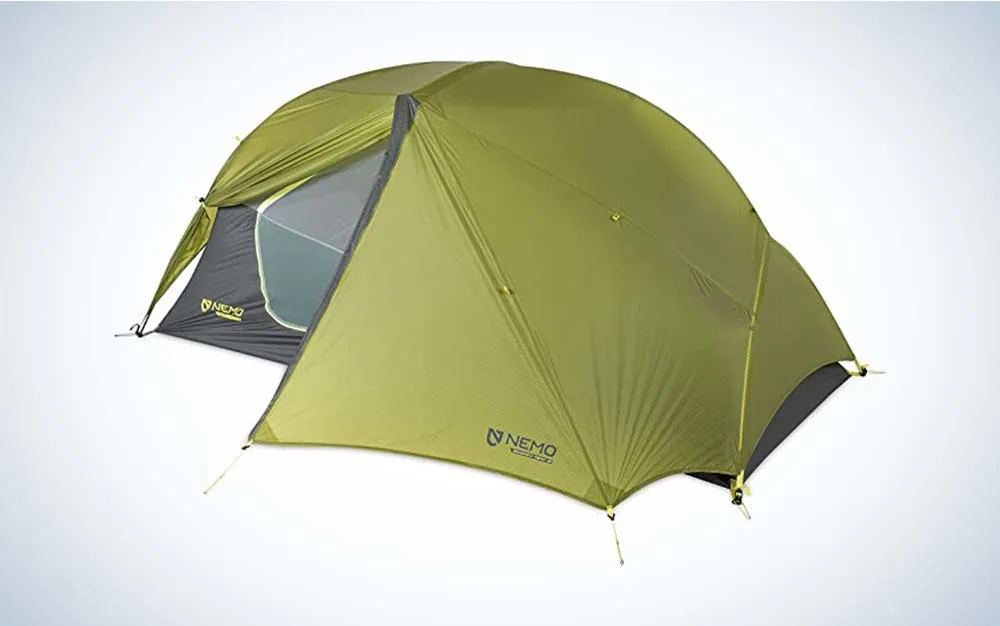
Nemo Dragonfly OSMO
Runner Up
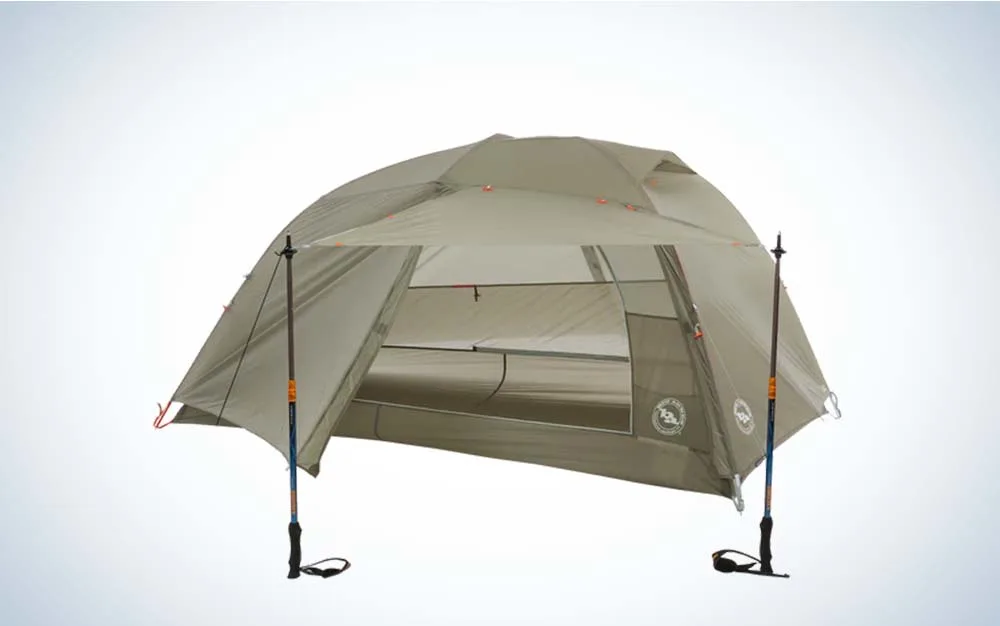
Big Agnes Copper Spur HV UL2
Best Under $200
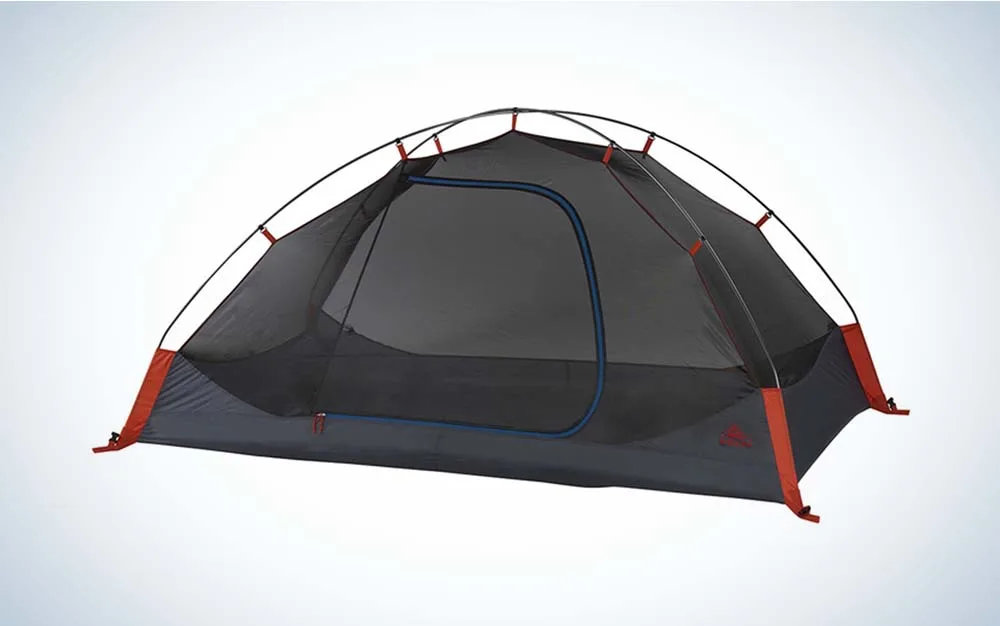
Kelty Late Start 2
The best 2-person backpacking tents are identified and chosen based on in-field experience evaluating tent durability, weather resistance, and comfort. The weight, price, and other features are also considered. Getting out on the trail with a backpacking tent
can be as simple as using the tent you already own, but if it is too big or heavy for backpacking, it may be time to find something new. Most two-person tents are large enough to fit two average adults (very snuggly, so I hope you like each other). I’ve also used 2-person backpacking tents on my own when packing with my dogs to ensure we all had enough room to sleep comfortably.
While all of the tents on our list are excellent choices, they all individually have pros and cons. Each one fits varying backpackers’ needs, from ultralight packers to cold-weather backpackers, as well as beginners or folks on a tight budget. We did not feature several brands on our list that design and manufacture fantastic tent options, so bear in mind these are just the tip of the iceberg in terms of backpacking tent options. The best tent brands
all have 2-person backpacking tent options, and all of those brands are featured on this list.
Best Overall: Nemo Dragonfly OSMO
Runner Up: Big Agnes Copper Spur HV UL2
Best Ultralight: Six Moon Designs Lunar Duo
Best 4-Season: MSR Access 2
Best Under $200: Kelty Late Start 2
How We Picked the Best 2-Person Backpacking Tents
Choosing the best 2-person backpacking tent has a lot to do with the packability and functionality in the field. Unlike car camping tents, backpacking tents need to have a high level of weather resistance and must be highly portable and durable enough to use in all conditions for extended periods. Like with any tent, the intended use is of the highest importance. While backpacking is a narrow focus already, the terrain, climate, distance, and individual fitness levels can influence the tent best suited for your trip.
Primary considerations in choosing the best 2-person backpacking tents include:
Portability: How packable is the tent, including a footprint? How much does the tent weigh? Is the tent easy to repack in the bag provided?
Durability: What is the projected lifespan of the tent? What is the product warranty? Is there a company repair policy? Does the tent come with a repair kit? Is the tent made from durable materials?
Set Up: Is the tent easy to set up and take down alone? Is it freestanding?
Comfort: Is the tent interior comfortable for two adults? Is there gear storage inside the tent or in the vestibule? Are there additional features that enhance comfort or organization? Is there adequate ventilation?
Weather Resistance: Is the tent a 3-season or 4-season tent? How does it stand up to high winds? Are the materials completely waterproof? Is the waterproofing PFC-free and nontoxic? Will the waterproofing need to be reapplied after extended use?
Other factors that influenced our choices include field testing and personal experience with products or brands, industry knowledge of product manufacturing and design, interviews with product developers, and verified customer testimonials. Products and categories are subject to change as further testing and research are conducted or when new products enter the market.
The Best 2-Person Backpacking Tents: Reviews and Recommendations
Best Overall: Nemo Dragonfly OSMO
Best Overall

Specs
Materials: 10D Nylon Ripstop, No-See-Um Mesh
Floor Area: 29 sq ft
Peak Height: 41 in
Packed Size: 19.5 x 5.5 x 3.5 in
Weight: 2 lb 10 oz
Pros
Two large vestibules
Light and packs down small
Interior pockets
Easy to set up, even alone
Bluesign approved fly & floor materials
Cons
Footprint not included
Tapered foot section cuts down on interior space
Price
Nemo Equipment has several outstanding backpacking tent options. My favorite among them is the Nemo Dragonfly OSMO Ultralight Backpacking Tent. Available in 1-person, 2-person, and 3-person sizes, the tent is made from lightweight, durable materials. The poly-nylon ripstop fabric has a high level of water repellency and resists stretching when wet while the OSMO fabric is made from 100% recycled yarn and is PFAS-free while still meeting flame retardancy without using harmful chemicals. The included stakes are also strong and good quality.
The first time setting the tent up took me around 8 minutes, and there were easy-to-follow instructions in the tent bag. I’d imagine with two people—or even after setting it up once or twice—you could do it in under 5 minutes. Whether carrying the tent on your own or with another person, it packs down small and is lightweight. The interior space is roomy enough for two average adults. I’d prefer if the interior weren’t tapered at the floor, but even with that feature, you have plenty of headspace and room in the vestibules for gear. Even with the tapered floor, there is still enough room for a 25″ pad with a 20″ sleeping pad
. Other features worth noting are interior pockets and the high arching main poles to increase the headroom when sitting up.
The materials are very lightweight, and we recommend investing in a footprint (sold separately) to help protect the tent floor. I have some concerns about the longevity of the tent materials, but all of the fabric is repairable, and Nemo has a lifetime warranty. With proper care, maintenance, and repairs, this tent will quickly become your go-to backpacking tent.
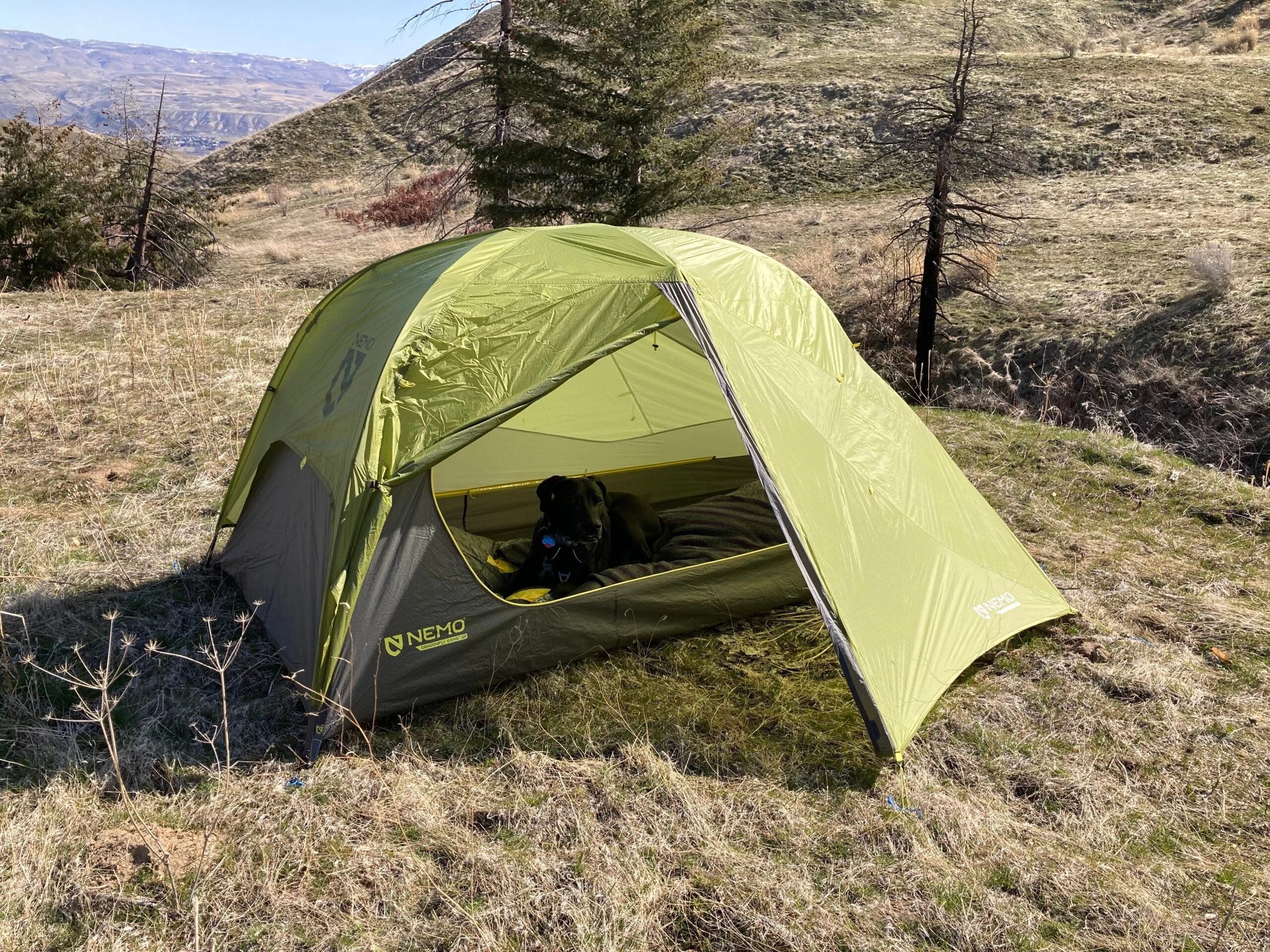
The Nemo Dragonfly OSMO is lightweight, easy to setup, and roomy enough for two average adults or the author and her dog. -Meg Carney
Runner Up: Big Agnes Copper Spur HV UL2
Runner Up

Specs
Materials: Double ripstop mixed denier nylon, polyester mesh, polyurethane coating
Floor Area: 29 sq ft
Peak Height: 40 in
Packed Size: 19.5″ x 6″
Weight: 3lb 2oz
Pros
Good size-to-weight ratio
Two large vestibules
Comfortable for two average adults
Color-coded poles/clips for easy setup
Secure in high winds
Cons
Price
Rainfly doors could align with tent doors better
Footprint sold separately
The overall design of the Big Agnes Copper Spur HV UL2 is highly comparable to that of our top pick, with the primary difference being a slightly higher weight. This one also has a tapered foot area but is still quite roomy inside the tent, even with two people. With two large vestibules, it is easy to create more interior space by storing gear outside the main tent area.
Two of the most important features in the best backpacking tents are portability and weather-resistance—and this tent blows both out of the park. Even though it has a roomy interior and two vestibules, it is highly packable. When set up correctly, the tent feels secure in high winds, and the water resistance is highly effective. Setup is a breeze with this tent and isn’t overly complicated. The color-coded poles and clips make for a straightforward and uncomplicated setup that takes under ten minutes, even when setting up the tent alone.
One note: Even though the large vestibules are one of our favorite aspects of the tent, the way the tent doors align with the rainfly opening could be more comfortable, and it takes some shuffling to get in and out of the tent.
Best Ultralight: Six Moon Designs Lunar Duo
Best Ultralight

Specs
Materials: 190T Polyester, 40D No-See-Um
Floor Area: 34 sq ft
Peak Height: 45 in
Packed Size: 15″ X 6″
Weight: 2 lbs 12 oz (trekking pole set up)
Pros
Single wall design
Silicone-treated materials for waterproofing
Roomy tent interior
Can be pitched with trekking poles
Cons
Stakes sold separately
Seams not sealed
Six Moon Designs has a variety of ultralight tents and tarps, perfect for a minimalist outdoor adventure. Utilizing a single-wall design, the Six Moon Designs Lunar Duo is a durable yet lightweight two-person tent option. Single-person tents will be far lighter than this one, but without the poles or stakes, the tent weighs less than 3 pounds (comparable to our top two picks).
What sets this tent apart from many others featured is the single-wall design. It is not a freestanding tent which can be a pro or a con depending on personal preferences. What we like about a single-wall design like this is that it is simple, roomy, and you can keep the interior dry when setting up in a rainstorm. The interior space is quite large and can easily fit two sleeping pads, even if they’re both wide/long sizing.
If you are not used to a single-wall tent design like this, there may be a learning curve to the setup, and we recommend testing it out a few times before you hit the trail. You can set the tent up using trekking poles or by purchasing poles compatible with the tent design. To ensure the tent is sturdy, secure stake and guyline placements are a must, so ensure you have a good area to set up, or it may be challenging to get enough tension on the walls. We recommend always using all of the guylines, even on the sidewalls, but at the very least, they should be used in windy conditions to minimize fabric movement. Overall, this is the ideal tent for any ultralight backpacker who wants a simple tent with high comfort and versatility.
Best 4-Season: MSR Access 2
Best 4-Season
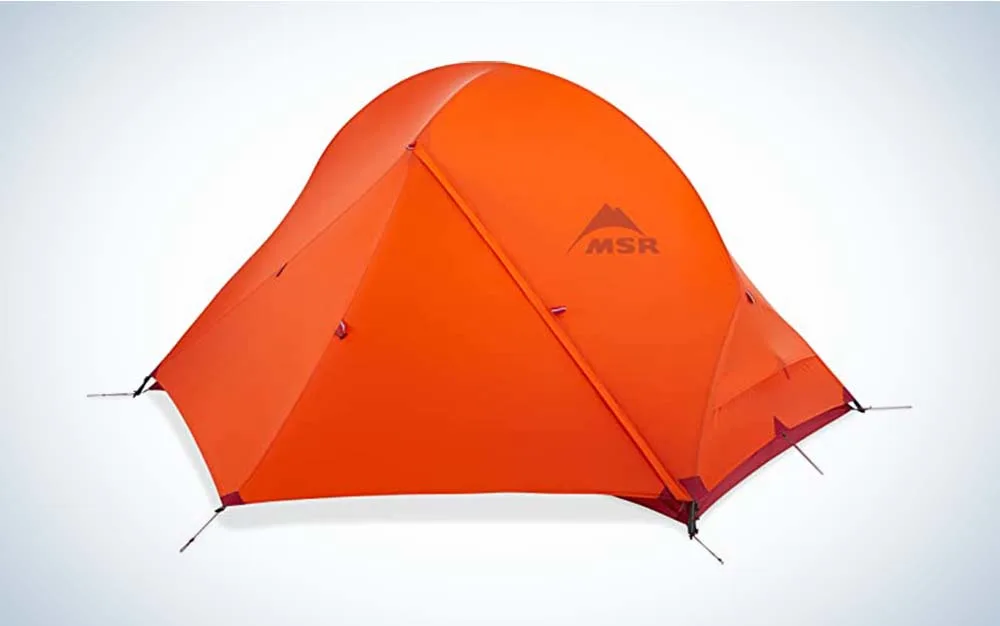
Specs
Materials: 20D ripstop nylon & DWR, Xtreme Shield™ polyurethane & silicone, 10D polyester micro-mesh
Floor Area: 29 sq. ft
Peak Height: 42 in
Packed Size: 18″ x 6″
Weight: 4 lbs 1 oz
Pros
Double wall design for adequate weather resistance
Excellent ventilation to minimize condensation
Easy to set up
Lightweight for a 4-season tent
Cons
Pack size could be smaller
Price
The MSR Access 2 is an excellent 2-person tent for 4-season camping expeditions. It is suitable for winter camping, and for its size and weather resistance, it is incredibly lightweight. In fact, it may be one of the lightest options out there for its level of performance. It has a double wall design that provides better protection in terms of heat retention and weather resistance. While ventilation and condensation are often a concern with four-season tents, this tent does an excellent job cutting down on the amount of condensation that occurs, which we appreciate.
It is an excellent tent for mild snowy conditions, lower level elevations during winter, or high elevations during summer and shoulder seasons. It holds up well to heavy rains, moderate winds, and light snow loads, so it will do a fine job for the average camper, backpacker, or ski tourer. There are better tent options for heavy snow loads or high winds in more technical mountaineering areas, however, given that the lightweight design makes it slightly less sturdy.
Best Under $200: Kelty Late Start 2
Best Under $200

Specs
Materials: 68D Polyester, No-See-Um Mesh
Floor Area: 29.5 sq ft
Peak Height: 40 in
Packed Size: 16″ x 7″
Weight: 4 lbs 8 oz
Pros
Affordable price for the quality
Quick and easy setup
Plenty of ventilation for summer camping
Durable floor design
Excellent weather resistance
Cons
One door and vestibule design
Many backpacking tents within this size range are priced well over $200, but if you’re searching for the best value tent, Kelty is a great place to start. While not the lightest option for a backpacking tent, the Late Start 2 is just over four pounds, making it more than suitable for a two-person backpacking tent. This is a three-season tent, and the amount of mesh that covers the tent walls is likely part of what cuts the weight down. Don’t let its lower price fool you about its field performance, either, especially in bad weather. When set up correctly, this tent holds up exceptionally well in stormy winds and rain storms. The tube-style floor helps protect you from any unwanted moisture coming in through the base of the tent, but we still recommend you use a footprint (sold separately).
I have used Kelty tents for years, and they are among the most durable and reasonably priced options I’ve found. I especially recommend a Kelty tent if you camp with dogs because the floor material is durable enough to withstand even the most aggressive dog nesting. The Kelty Late Start 2 may not be the roomiest or the lightest weight option for backpacking, but split between two hikers, this tent is a highly functional and long-lasting tent option with an unbeatable price.
What to Consider When Choosing a 2-Person Backpacking Tent
Intended Use
If you’re looking to purchase a 2-person backpacking tent, it is implied that you’ll be backpacking and potentially have a partner with you. Larger tents, like family camping tents
or car camping tents, aren’t suitable for carrying longer distances because of their weight and size. There are still several instances when an individual may choose a 2-person backpacking tent instead of a one-person tent. For example, I often backpack alone but bring one or both of my large breed dogs. A two-person backpacking tent is more suitable for me than a one-person tent so we can all sleep comfortably.
The backpacking terrain and time of year may also influence your buying decision. If you tend to backpack strictly during the summer, a 3-season ultralight tent should be sufficient. If you prefer to backpack year-round or in high-elevation locations, considerations might be necessary for a 4-season or sturdier 3-season tent.
When considering the terrain you’d like to cover, also consider your fitness level. Are you looking for an ultralight setup, or are you okay with a few extra ounces here and there? These questions can help you narrow down not only the type of tent that is best for you but the weight, size, and packability.
Size and Comfort
Most 2-person backpacking tents will still be relatively small to ensure they are packable enough for the trail. That said, their design is intended to fit two people while sleeping with either no or minimal gear inside the tent with you. To make room for gear, there should be at least one but preferably two vestibules included in the design where gear like backpacks can be stored. Many people choose a two-person tent if they want more space while they sleep and to allow for the option to keep their backpacks inside the tent.
The size consideration should also include the headroom. Backpacking tents only provide enough room to sit up inside the tent. Some will have more headroom than others, so the peak height and the floor area should give you a good idea about how much space you have to move around inside the tent. If the tent floor is tapered in the foot well, it makes the tent feel smaller. This is a compromise because the tapered end of the tent also cuts down on the weight of materials. Our two top picks, the Nemo Dragonfly OSMO and the Big Agnes Copper Spur UV HL2 both have taper footwells, but we still felt that they provided plenty of interior space for two average adults.
In the end, if you use a two-person tent for two people, you better really like each other because you’re up close and personal. My primary backpacking partner and I always share a two-person tent, and we are two average-sized females. While it can feel cramped at times, when camping in colder seasons, sharing the space does allow us to optimize body heat and gives us a chance to chat, listen to podcasts, or play games together before we go to sleep.
Weight and Durability
The best 2-person backpacking tents should be under four pounds and ideally within the two-pound range if they’re on the ultralight side. Since a 2-person tent is meant to accommodate two people, they likely have two doors and vestibules, which requires more fabric and increases the overall weight of the tent. While the weight is essential, it is also worth remembering you can split the tent between you and your hiking partner, allowing you to carry a heavier tent than you might on average. For example, for years, my backpacking partner and I carried a six-pound tent. While this tent is a bit heavy when I am on my own, split between the two of us, it is far less noticeable.
The materials the tent is made from also influence the weight and packability. Most backpacking tents are made from synthetic materials like polyester or nylon, which are lightweight and durable. The thickness of the fabric varies from tent to tent, and to identify how thick and robust the material is, look at the denier number. The higher the denier, the thicker the tent fabric fibers are for that tent section. Most tents have different denier numbers for the tent body, floor, and rain fly.
How much of the tent body is made up of a mesh material also impacts the overall weight of the tent. Mesh is lighter than polyester or nylon, so if most of the tent body is mesh, it will be a lighter tent overall. When a tent has a high level of mesh, it is great for summer camping, but pay close attention to how high the floor is and if it has a tub design to prevent moisture from entering from the bottom of the tent area.
The tent poles are another part of the tent that can add a lot of weight. Many backpacking tents utilize aluminum poles which are affordable, lightweight, and highly durable. Another very durable and lightweight material is carbon fiber. It is slightly less common in mainstream backpacking tents because of the high price, but you may see it used for more technical products. Fiberglass poles are the most affordable tent pole option, but they are heavier and not quite as strong in the long run.
Ultralight tents are thought to be less durable than other options because of the lightweight fabric. While this may be true in some cases, advances in fabric technology have allowed ultralight options to be reasonably comparable to more traditional tent designs in terms of durability and weather resistance. Proper maintenance, storage, and care of products is often the most significant factor in how long it lasts. If you are concerned about durability, opt for a brand like Nemo Equipment or Big Agnes that offers lifetime warranties or repair policies.
While all of that is a lot to think about, the nice thing about online shopping is that you can easily reference the technical specifications of products. Companies outline all of these details and often provide both a packed weight, minimum weight, and a packed size of the tent.
Weather Resistance
The weather resistance of any camping tent is vital, especially for a backpacking tent. Weather resistance includes a tent’s ability to withstand moisture like rain and snow, but it also needs a strong and sturdy setup to withstand potential high winds. How a tent is set up and if it is set up correctly can influence the performance, but in general, the tent should protect the campers from the elements no matter the conditions.
Fabric types and coatings like DWR, silicone, and water-based PFC-free solutions are a few examples of popular waterproofing tent materials. Many tents also have fire retardant properties incorporated into these coatings for higher levels of safety that may be worth considering when traveling in areas with frequent fire hazards.
Looking at the tent design and construction can also tell you a lot about the weather resistance. For instance, the Six Moon Designs Lunar Duo tent featured above is the only tent that made our list that still needs its seams sealed. It is ideal for seams to be sealed on a tent to provide additional water resistance. Moisture covers on zippers are another feature that can further protect the tent from allowing moisture to enter.
How the tent is secured to the ground, and the pole structure is essential to note, especially when camping in areas that may experience high winds. Using guylines isn’t always necessary, but having the option to not only stake out the tent but secure the sides and fly with guylines provides more security during a storm or in exposed areas with little tree coverage. Freestanding tents are generally very easy to set up but do not require as strong of stake placement. So tents need very secure staking to withstand a storm which can cause problems if you find yourself in a particularly rocky area.
Ease of Use
Finally, ask yourself: how easy is the tent to set up? Smaller tents are much easier to set up and take down than larger tents, but the overall tent design should be straightforward for all users. Freestanding tents are the easiest to set up, while other tent designs may have a slight learning curve. Tents that offer instructions attached to the tent bag and color coding are ideal for cutting down on the setup time. Regardless of how easy the tent should be to set up, we do always recommend setting up the tent at least once before your first trip to make sure you have all the pieces, there are no defects, and so you know exactly how to set it up before you hit the trail.
Other features like gear lofts, interior pockets, vestibules, and footprints all enhance the ease of use when camping. So, beyond the tent set up and packing, look at how easy it is to get in and out of the tent, where there is gear storage, and if features like vents make sense.
FAQ
Q: Is a 2-person tent big enough for 2 people?
Yes, the average 2-person tent is large enough to fit two people, but hopefully, you’re very comfortable with one another because it is a snug fit. Most two-person tents are only around 7 feet in length and 4 feet wide, sometimes slightly larger. That often only leaves room for two average adults to sleep side by side in the tent and almost no room for gear inside the tent. When sleeping with two people inside a 2-person tent, save space by storing equipment in the vestibules.
Q: What is the lightest 2-person hiking tent?
The lightest 2-person hiking tent on our list is the Six Moon Designs Lunar Duo. Most two-person backpacking tents weigh 2-6 pounds, and ultralight two-person tents are closer to 1.6-2 pounds, with some variation in weight by tent design. If you are using a 2-person tent with two people and not on your own, having a heavier tent is easier to manage because you can split the weight between two people.
Q: Is a 2-person tent too small?
For some campers, a 2-person tent is too small for their needs. Looking at the tent dimensions and paying attention to the tent’s length, width, and height when it is set up gives you a good idea of the size of the tent. If you prefer more space when sharing a tent with another person, a 2-person tent will be too small for your needs. If you are comfortable with your backpacking partner and don’t mind sleeping in close proximity to them, a two-person tent is large enough for two average-sized adults.
Q: What sleeping pads fit into a 2 person backpacking tent?
Most sleeping pads for camping
and backpacking fit inside a two-person tent and a one-person tent. If you want a sleeping pad that covers the entire base of a two person tent, look into tent floor or floor mat sleeping pads. To get a floor mat that fits your tent comfortably, buy one from the same brand as your tent or even one that’s designed specifically for your tent model.
Q: How heavy is too heavy for a backpacking tent?
How heavy is too heavy for a backpacking tent depends on your backpacking style and how much weight you’re comfortable carrying. When packing a tent with two people, you can get away with a heavier tent because the weight is split between two people. Most 2-person backpacking tents weigh between 2-6 lbs but can be heavier, especially if they’re a 4-season tent. Ultralight tents have become more mainstream and tend to be favorable for many hikers, but your intended use, backpacking style, and group size can influence the best tent weight.
Final Thoughts on the Best 2-Person Backpacking Tents
Best Overall: Nemo Dragonfly OSMO
Runner Up: Big Agnes Copper Spur HV UL2
Best Ultralight: Six Moon Designs Lunar Duo
Best 4-Season: MSR Access 2
Best Under $200: Kelty Late Start 2
The best 2-person backpacking tents are lightweight, durable, and roomy enough to fit two adults. Each person has a different goal and approach to backpacking, so the perfect tent for your trip may be the Kelty Late Start 2, while the best one for me could be the Nemo Dragonfly OSMO. These decisions often come down to our budget, the terrain we intend to hike, and how much weight we are willing to carry. If you’re a beginner and want an excellent introductory tent, we recommend renting or borrowing a tent. When backpacking with a partner, simply sharing their tent is a great place to start. These options allow you to try several designs and brands to find the best tent
for your backpacking needs.
Why Trust Us
For more than 125 years, Field & Stream has been providing readers with honest and authentic coverage of outdoor gear. Our writers and editors eat, sleep, and breathe the outdoors, and that passion comes through in our product reviews. You can count on F&S to keep you up to date on the best new gear. And when we write about a product—whether it’s a bass lure or a backpack—we cover the good and the bad, so you know exactly what to expect before you decide to make a purchase.

